Introduction
E-tailers face a maximum surge in their business during holidays and festival times. Order volumes increase significantly, over and above the average demand graph, thereby creating a peak season warehouse impact.
During this period, sales volumes increase from anything between two to ten times, thereby generating a misappropriation between volumes and revenue. This explains an automatic surge in activity that warehouses face for several months in lieu of meeting the high demand for the products during the peak season.
What needs to be done is to channelize and manage things ‘the right way at the right time.’
This surge in demand for products during the peak season has a domino effect on warehouse fulfillment that comes as a savior.
How Do Peak Seasons Impact Warehouse Fulfillment?
Here are a few ways peak seasons impact warehouse fulfillment:
Leads to Volume Increase and Inventory Overflow
A significant increase in demand during a short time leads to higher volumes and greater risks for delayed orders and dissatisfied customers if the orders are not met on time. To ensure the continuity in demand-supply flow, a good warehouse fulfillment network can be of great help.
Warehousing channels now have the latest technologies that help manage volume fluctuations and even provide an update of the supply chain data so that you can monitor and make decisions more precisely and accurately at any given point in time.
Supply Chain Labor Challenges
With an increase in demand for products comes an increase in the demand for a flexible labor force, too. You need a robust setup of the workforce to help in managing, storing, picking and packing, providing last-minute delivery services, and so on.
To avoid this situation during the peak season, it is best to arrange for extra hands well in advance and even provide sufficient training to them to meet the shortage challenges.
Warehousing activities these days provide scalable automation solutions that can not only increase your production but also utilize the available warehouse space more effectively and efficiently.
Increased Transportation Cost
The price hike in diesel and petrol prices makes transporting of goods more expensive. This needs to be kept in mind by e-tailers to find more efficient shipping methods that can help offset these added expenses.
This includes finding more efficient shipping methods, adapting effective operation and shipping solutions, and so on.
In the given situation, fulfilling orders from warehouses closer to your customers and introducing in-house value-added services comes as an answer to cut down on transportation costs.
Returns and Reverse Logistics
A surge in sales indefinitely results in a surge in returns as well. As a retail business owner, you need to have a backup of a robust returns pick-up delivery team that ensures a smooth return experience.
Failing this would cost you both revenue and reputation. Having the right process in place that avoids any kind of interruptions in reverse logistics can fetch you better customer satisfaction and loyalty.
A seamlessly integrated reverse logistics team that syncs well with your current supply chain and logistics process can make things work in your favor.
Wrapping Up
Warehouse fulfillment during peak season has many value-added advantages to the business as it extends support in reducing risks, complexities, and even costs in more ways than one. For a retail business, its importance cannot be undermined.
Warehouse fulfillment companies like Shipyaari have the expertise and experience to handle peak season warehouse impact most diligently and systematically.
If you are in an e-commerce supply chain business and want support with the peak season surge in demand for your products, try a demo with us and get instant solutions for your business module with a single click.







 Shipping
Shipping







